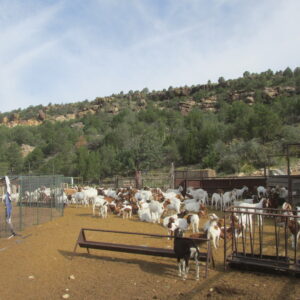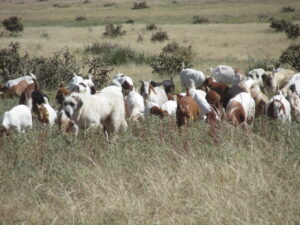Project Overview
Information Products
Commodities
- Animals: goats
- Animal Products: meat, other
Practices
- Animal Production: animal protection and health, free-range, grazing - multispecies, livestock breeding, rangeland/pasture management
- Education and Training: farmer to farmer, networking, on-farm/ranch research, workshop, youth education
- Farm Business Management: budgets/cost and returns
- Sustainable Communities: sustainability measures
Summary:
 Does and kids are confined and all feed/water supplied[/caption]
Does and kids are confined and all feed/water supplied[/caption]
This project has explored two different methods of kidding (birthing) goats in a multi species program of grazing. Research has tracked and documented the pros/cons of Intensive kidding vs Extensive kidding programs. Intensive kidding is known to be high in labor, costs of feed and health maintenance of does and kids. This results in a lower profit margin from kid sales which threatens economic sustainability.
It is now believed an Extensive kidding method will increase the number of live kids raised from birth to sale as well as reducing labor and costs of kid goat production in and Open Range program of multi species grazing. In years 2 and 3 of this project (2023-2024) data has been collected to show that an Extensive program of kidding does out in two connected traps can reduce cost of feed, labor and result in kids that are able to follow their mothers earlier, resulting in a higher percentage of live kids surviving until market.
Please note that adult losses in both groups were due to a freak winter storm which occured first of May in 2024.
In 2024, the Intensive Kidding Pens (IKP) group started with 45 does. 4 does aborted and were turned back into open doe herd. The remaining 41 does represented 44% of the bred does in 2023. The IKP group earned a gross average of $127.53 per doe. After expenses, IKP kids earned a net average of $44.93 per head. Total feed cost for the IKP group was $3,799.00 or 66% of the total feed used in 2024. The EKP group started with 49 does but after 4 does died and 2 aborted due to a freak winter storm, the remaining 43 does represented 46% of the does bred in Dec of 2023 for 2024 kids. The EKP kids' gross average revenue was $157.22 per head. After expenses, the net earnings from the EKP group in 2024 was $125.28 per hd. Total feed cost for the EKP kids in 2024 was $1,948.00 or 34% of total feed cost for 2024. Also, 51% of the IKP kids made it to sale while 57% of the EKP kids made it to sale. It is believed this difference of live kids to market is a direct result of poor bonding within the IKP group and good bonding in the EKP group.
In 2023, the Intensive Kidding Pens (IKP) group consisted of 45 head and represented 58% of bred does in 2023. The IKP group earned a gross average of $56.04 per doe. The net revenue of kids for the IKP group averaged a loss of -1.00 per kid/head after expenses were applied. The Extensive Kidding Pasture (EKP) consisted of 32 head and represented 42% of does bred in 2023. The EKP group earned gross average of $94.14 per doe. The net revenue of the kids for the EKP group averaged $30.12 per kid/head profit. 2023 documented a positive results for the Extensive Kidding Pasture revenue vs Intensive Kidding Pasture revenue. Year 3 test kids are due to arrive in May of 2024. The results from the 2024 kidding/sales season have helped determine that the Extensive Kidding program is sustainable and results in higher revenues.
[caption id="attachment_973664" align="alignright" width="300"] Does and kids grazing in Extensive kidding program in small traps.[/caption]
Does and kids grazing in Extensive kidding program in small traps.[/caption]
An increase in marketable kids while reducing labor and cost inputs has created a greater profit margin for a sustainable multi species grazing program. This project was designed to determine if the losses of kids, cost of feed and labor can be reduced in an Extensive kidding program. We believe it has done so. Reduction of these factors has resulted in an increase of live kids making it to market sales and which has created a greater profit margin for sustainable multi species grazing program. The pros and cons of Extensive vs Intensive kidding management have and will continue to be disseminated to the Ag community via Social Media, Multi Species Grazing workshops and rancher to rancher.
Project objectives:
- Design and build two kidding traps adjacent to each other and a working set of pens for identifying and moving pregnant goats to kidding traps as needed.
- Document, record and rate all births possible and compare whether Intensive or Extensive kidding programs produce the greatest number of live kids.
- Track feed and labor costs of each type of kidding program to see which is the lower in cost and labor to determine total cost of production of marketable kids.
- Monitor kidding traps for soil improvement and grass restoration during non- kidding season when traps will be rested.
- Identify the best type of kidding program ranchers can adopt to create an additional sustainable source of revenue as well as improving their land. Share the information discovered through educational programs and social media presentations.